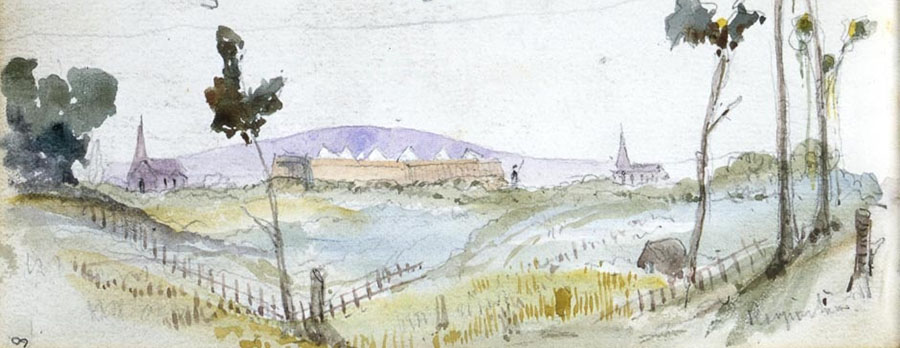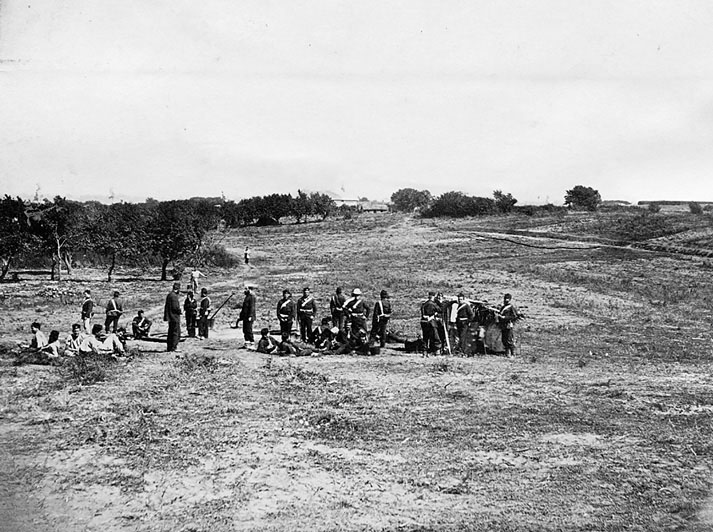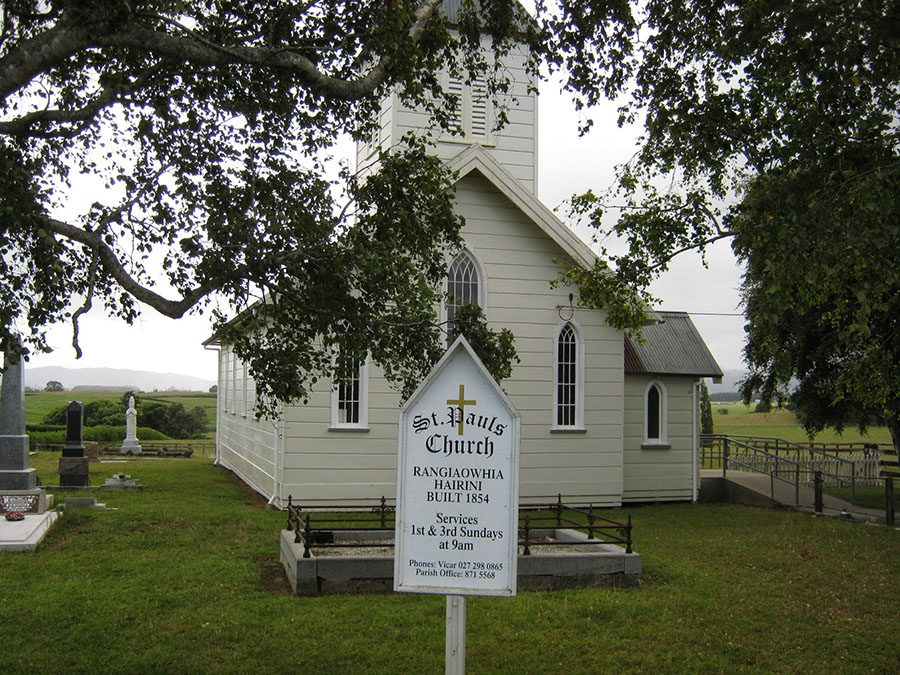OTAHUHU WAR MEMORIAL UNDER ASSAULT
You really have to wonder, does anybody in New Zealand actually read history books these days?

Colonel Marmaduke George Nixon and his memorial at Otahuhu.
Recently, Maori activist, Shane Te Pou, fresh from a trip to Charlottesville, Virginia began circulating a petition to have the Otahuhu memorial to Colonel Marmaduke George Nixon removed on the pretext that Nixon was a “war criminal”. This incentive follows on the heels of the campaign to have confederate soldier statues in the Southern United States torn down and the South’s civil war memorials erased from history. Obviously, former list MP, Te Pou, is using this pretext as a political football to advance his own ambitions and profile before the public.
Te Pou stated on national TV that, ‘this guy is an historical thug, he’s a war criminal. Him and his troops rounded up Maori women and children, locked them in the church and burned them down and here we are celebrating his life through an oversized monument in modern day Otahuhu and I think it’s gotta go’.
He went on to reiterate this on several occasions in his interview with Duncan Garner, stating yet again, ‘he was a war criminal Duncan! Him and his troops rounded up Maori women and children, put them in a church, locked the church and burnt them and killed them and we ought not to celebrate his life’.
Duncan Garner then asked Te Pou, ‘Does this come off the back of America with the confederate statues and things like that?’
Te Pou, flushed out and exposed as to his mischievous, true intent and agenda, acted quite flustered, then hummed and harred, ‘well, I ah, I, I , look, I was recently in Charlottesville, I, I came back, I studied this particular monument and I thought, you know, I thought, those ah, those ah, souls in Charlottesville were very brave and I thought, well, look, I think there are statues in New Zealand, particularly this one that I’ve known about for many years, that we ought to discuss and we, ah ought to put up for public debate and that’s what I’m trying to achieve Duncan.
Like the Tui beer ad said, Yeah Right!
http://www.newshub.co.nz/home/new-zealand/2017/09/call-to-move-colonial-statue-in-auckland.html
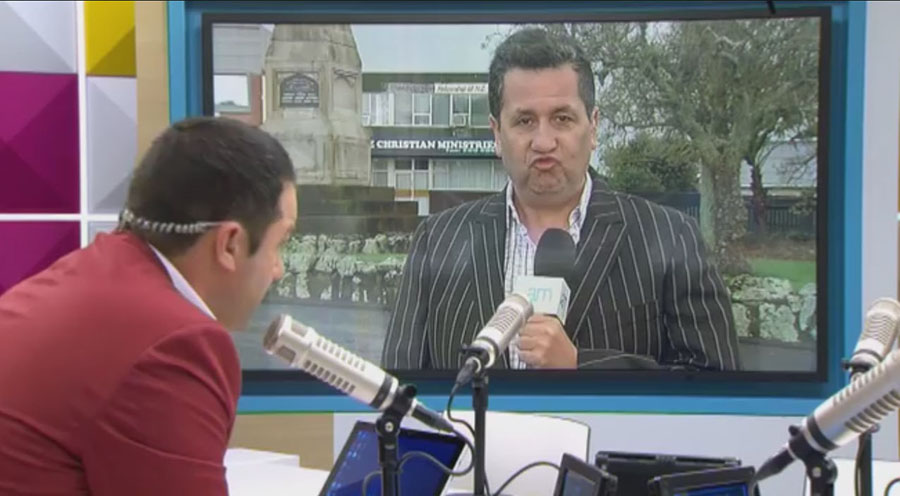
Down-in-the-mouth Shane Te Pou, fresh from Charlottesville and in full swing, putting the boot into Colonel Marmaduke George Nixon, calling him a war criminal and wanting his memorial removed.
It’s obvious that rabble-rouser Te Pou has been inspired by the demonization and destruction of civil war (1861-1865) monuments of the American south and now wants to stoke up a similar campaign to destroy colonial monuments of the NZ Wars (1845-1872). Now, prejudiced and truth-challenged Peeni Henare, Labour Party candidate, has joined the fray and made it part of his election platform to have the monument rededicated to the so-claimed victims of Nixon’s alleged, murderous war crimes.
But let’s explore Te Pou’s accusations on the basis of true, documented history to see if any of them have an ounce of validity.
THE BATTLE OF RANGIAOWHIA
By 1864 The Maori King movement had built heavy defences at Paterangi and Rangiatea which would have been very difficult to attack and breach without considerable loss of life on the part of the colonial troops, Maori support troops loyal to the government and Kingite defenders behind the PA fortifications.
But as General George Patton of WWII fame would have said, ‘The object of war is not to die for your country but to make the other bastard die for his’. A smart, responsible commander will always try to find a tactical solution or strategy that seeks to destroy the enemy's ability to wage war, while preserving the lives of his own men and minimising their casualties.
Lieutenant-General Duncan Cameron concluded that if he could somehow scoot, undetected past the Kingite defences and capture Rangiaowhia, the critical food producing area of the enemy, he could cut off their sustaining supplies and bring the war to a swift conclusion. It was a brilliant and daring tactic, but not without great risk. Two of the pro-government Maori guides provided expert intelligence related to the topography of the countryside and trackways that could be used to elude enemy sentries. The colonial troops would have to silently bypass the Kingites and remain totally undetected for the out-flanking ruse to work.
Nearly 1000 men carefully wound cloth around anything that would rattle or clunk and were under strict orders to maintain absolute silence at all times. Horse hooves were similarly wrapped. The troops quietly broke camp in darkness at 10 pm and with ever-vigilant stealth followed the guides through the night to the outskirts of Rangiaowhia, which came into view at daybreak. The Kingites had been remiss in not sufficiently fortifying this strategic, farming location and flour mill. This was to become their Achilles ’ heel and undoing, as their war effort was wholly dependent on the preservation of these vast farm fields of wheat, corn, potatoes, pigs, fowl and fruit orchards, if they were to carry out sustained, long-term warfare.
The steeples of both the Catholic mission church and the English CMS mission church, situated only a quarter of a mile apart, came into view as the colonial troops moved quickly forward through the morning mists, taking the Rangiaowhia garrison completely by surprise. Gun fire alerted Maori defenders, of which there were about 100 men, along with women and children. Many armed Maori soon took refuge in the Catholic church and were bypassed when they showed a white flag of surrender. Similarly, the English church was crammed with Maori combatants and some shots were fired at the colonial troops from the windows.
The main Maori counter-fire came from two weatherboard houses and a series of raupo huts, one of which was large and had a sunken floor, down in which defenders could lie while returning fire at the colonial troops. It was from this main garrison whare that Colonel Marmaduke George Nixon received a mortal wound, shot in the lungs, when en-route to enter the dwelling.
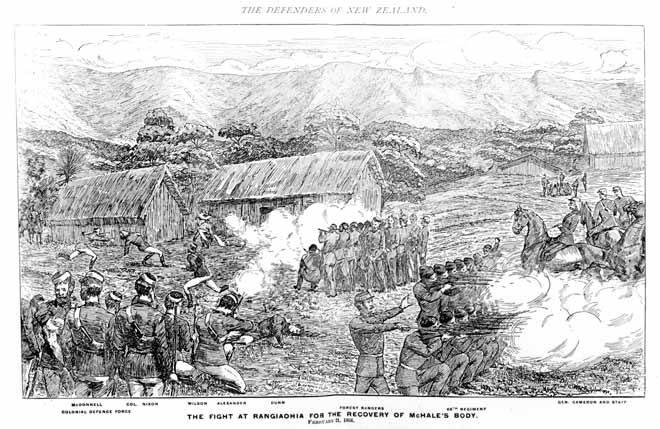
Colonel Nixon is depicted wounded and falling on the left side of this picture. He lingered for 3-months thereafter with his terrible wound and died on 27th of May 1864.
What transpired at the whare, leading to the deaths of its 10 occupants and 5 government troops alike, was witnessed by the Maori boy Potatau, grandson of chief Hoani. He had seen the soldiers coming by the whares and testified: "I at once ran to my father's house. I had not been long there when my grandfather [chief Hoani] came to the same house. ... so that he might die with us - [Chief] Ihaia, Rawiri and his son. At this time myself and my mother went outside the house, and sat at the door of the house. I heard my father say to my grandfather: 'Let us lay down our guns and give ourselves up as prisoners.' ... My grandfather would not agree. At this time the soldiers came to us, and asked my mother in Maori: 'Are there any Maoris in the house?' She replied: 'No, there are no Maoris in the house.' My father at once said: 'Yes, there are Maoris here.' The European who spoke Maori came to the door of the house, and caught hold of my father, and handed him over to the soldiers."
Captain Wilson assigned Sergeant McHale, the sole Australian volunteer, to enter the hut and take the occupants prisoner. Potatau continues: "The European went inside of the house. My grandfather shot him and killed him. Some of the others dragged the body in the house. At this time my mother and self arose and went through the soldiers and between the troopers. They did not interfere with us, but allowed us to pass. We went to the house of Thomas Power, who had a Maori woman to wife. After we left we heard the soldiers firing. ... [After] the firing had ceased [ we] at once left the place and ran off to the bush, and made for Rangitoto.” (See: Brett’s Historical Series, ed. Thomson W Leys & H Brett, Auckland, 1890).
Another eye-witness account states:
“Captain Wilson called out ‘What are you shooting the Maoris for? and jumping from his horse was into the hut in a moment. The door was so low he had to stoop to get inside. The place was full of smoke, and as Captain Wilson entered he found under him McHale’s body, his feet towards the door, and face down. The captain could not see anyone else for the darkness and smoke, consequently he soon backed out, calling out that McHale had been shot, which the men no sooner heard than with their carbines they commenced to riddle the house, which was built of slabs. The firing soon brought together the whole of the cavalry, and after a while some of the 65th and Forest Rangers, also the general and staff, came up. It was after General Cameron’s arrival that Colonel Nixon was shot from the door of the whare. Then, as the Maoris did not surrender when challenged for the second time, the infantry fired the house. I saw one Maori walk out of the blazing hut, his blanket singed on his back. Poor fellow! He fell within ten paces of the door whence he and his compatriots had so wantonly shot our colonel and many other good men. There was nothing now to prevent us from recovering McHale’s body, but its condition was such that we could hardly distinguish it from the Maoris around him.” (See: One Who Was There, Brett’s Historical Series, ed. Thomson W Leys & H Brett, Auckland, 1890).
Of the one who walked out of the blazing hut, Cowan says: "A tall old man, clothed in a white blanket [twisted to a white flag in some modern tales] ... emerged from the doorway of the burning house. His upstretched arms showed that he had no weapon. 'Spare him, spare him!" shouted the nearest officers. But next moment there was a thunder of shots. ... the old hero ... swayed slowly and fell dead to the ground. The episode enraged the chivalrous officers who had entreated quarter for him."
Bruce Moon (no relation to Paul Moon) observes: ‘The irony of all this is that the "old hero" must have been Potatau's grandfather who had fired the shot which killed McHale and started the whole fracas. Almost the last survivor, he had realized that the game was up and walked out to meet his fate. Had he heeded his son's advice at the start to give themselves up, none of it would have happened’.
Historian James Cowan wrote: ‘Four cavalrymen, including Sergeant Hutchinson and Trooper E. Mellon, rushed forward with a stretcher and carried Colonel Nixon out of the line of fire. Then they went back for Trooper Alexander, who was lying outside the door shot through the throat. The shot had been fired at so short a range—only a few feet—that his whiskers were burned by the powder-flash’.
And therein lay the reason why the raupo whares, including the large garrison one, caught fire and burnt down … powder flashes.
The tinder-dry raupo siding began to burn due to the internal and external volleys from the carbines, which sent tongues of fire and burning wadding soaring well beyond the muzzle. Several raupo huts eventually caught on fire and burnt down, with the main garrison whare inferno taking the lives of about 7 combatants still inside, from an original entrenched group of 10.
Some Maori defenders, escaping from the burning huts and houses, rushed to the Catholic church on the hill and joined other combatants in place there who were engaged in firing on the troops from the windows. When it was realised that the weather boards of the church were not thick enough to stop the bullets of Von Tempsky’s rangers, the occupants fled from the church to the nearby swamps.
According to Cowan, all in all 12 Maori, including chiefs Hoani and Ihaia, were killed that morning, with just over 30 prisoners taken. The colonial troops lost 3 men on the day, with another 2, including Nixon, mortally wounded and dying agonising deaths months later.

A map showing the Rangiaowhia terrain and locations where the main fighting took place.
See: The New Zealand Wars: A History of the Maori Campaigns and the Pioneering Period: Volume I (1845–64), chapter 37: The Invasion of Rangiaowhia http://nzetc.victoria.ac.nz/tm/scholarly/tei-Cow01NewZ-c37.html
For a comprehensive, documented account see: Bruce Moon’s rebuttal of Vincent O’Malley’s Listener article for 25th February 2017 at: http://breakingviewsnz.blogspot.co.nz/2015/10/bruce-moon-rangiaowhia-incident.html
Von Tempsky’s account: http://nzetc.victoria.ac.nz/tm/scholarly/tei-CowOldF-t1-body1-d7.html
The two churches at Rangiaowhia, built well before the NZ Wars of the 1860s, survived the battle intact. Bullet holes in the Catholic church were later patched up by Rev. Father Vinay. Here’s a quote:
Mr. William Johns Auckland, who served as a corporal in the Forest Rangers, says, regarding the firing at the Roman Catholic church, Rangiaowhia:—
“The Natives took cover in the Roman Catholic church after most of the whares on the lower ground had been cleared of them; the huts were nearly all set on fire by natives firing through the raupo walls at the troops. The church was held by them for only a brief period; they retreated quickly before the advancing Forest Rangers and troops. The Rev. Father Vinay, who resided at the church for many years after the war, cleverly effaced and closed up the bullet-holes left in the building during the skirmish, and yet these were long visible upon close inspection. The temporary stand made by the natives in the church formed the closing scene of that morning's encounter.
“A great deal of wild talk arose as to the burning of the Maori whares designedly, but the firing of Maori guns and of soldiers' rifles at close range into dry raupo whares is a sufficient explanation.”
The Catholic Mission was finally abandoned years after the battle and demolished due to a declining congregation and only the Catholic cemetery survives to this day. However, St Pauls English church still survives and is in good repair as one of the two oldest buildings of the Te Awamutu district.
A painting by Edward Arthur Williams, 1824-1898, showing the Catholic church (left) and Anglican church (right) with Blewitt’s redoubt in between. The redoubt was built quite some time after the battle of February 21st 1864.
Government troops at Rangiaowhia shortly after the battle, with what appears to be the Catholic church in the background.
St Pauls Anglican church, still standing and in good repair 153-years after the battle.
And so, Shane te Pou, scholar par excellence in cultural-Marxist propaganda history, please provide the rest of us with documented evidence to support your cowardly accusations against the integrity of a brave, fallen soldier, Colonel Marmaduke George Nixon.
Please provide evidence that, ‘Him and his troops rounded up Maori women and children, put them in a church, locked the church and burnt them and killed them…’
Please explain how the two church buildings of Rangiaowhia survived the battle intact and neither was ever burnt down.
With the “church-burning” myth disproven years ago, those intent upon keeping the false rumour of atrocities alive have reverted to yet another despicable tactic. They’ve retreated to an untenable claim that the main garrison whare, from which Nixon, McHale, Alexander, Ballander and another trooper received their mortal wounds, was a raupo whare Karakia or church.
Potatau’s testimony and that of many other witnesses demolishes that untruth.
Here’s a quote from Tamoe Ngata: ‘The author wishes to clarify that references to the burning whare* throughout the report are in reference to the raupo whare which local Maori used as a church or dwelling and then sheltered in during the siege. While some Maori may have sheltered in the wooden Catholic Church during the siege, it was these raupo whare* which were burned while people took shelter within. These raupo whare were also near the Catholic Church establishment, not only at the southern end of Rangiowhia Road’.
Tamoe Ngata further writes: ‘To add insult to injury, seven of their people died within the walls of the make-shift whare karakia, where they served as good Christian people’. (See: Registration Report for a Wahi Tapu, Rangiaowhia, Te Awamutu (Register no. 9634), 26th November 2013).
Of course, the only raupo whare in which 7 out of 10 very determined Maori combatants died by smoke inhalation, suffocation and fire was the main garrison whare, the deadly volleys from which ultimately took the lives of 5 government soldiers. To simply call these dangerous sharp-shooters good devout Christians, assembled for their morning prayers (karakia), stretches credibility to the limit.
Tamoe Ngata further writes: ‘According to an article in the Hawkes Bay Herald (1864), the seven who died in the raupo whare at the southern end of Rangiaowhia Road, were buried together in one grave which was dug on the south side of the church and the Right Reverend Bishop performed a burial service for them in the Maori tongue’.
The Raupo hut where the 7 people perished by fire was in the lower valley and not up on the hill adjacent to the Catholic church. By a series of poison-pen, disjointed statements and half-truths, Tamoe Ngata weaves a web of deceit, in trying to give the impression that there was yet another raupo whare karakia on the hill, where devout Christian, Maori women and children perished in a deliberate act of genocide carried out by government troops. There is no historical documentation to back his hate-based claim.
This is the kind of dreadful, uninformed scholarship that we have come to expect from Maori activists like Shane Te Pou, the Waitangi Tribunal and a raft of Marxist social-engineers posing as historians. Also, the fact that the fake news media never investigates this palpably false history is appalling. Interviewer, Duncan Garner seems to have just swallowed Te Pou’s rant, hook, line and sinker as legitimate history and Dr Paul Moon didn’t exactly go out of his way to enlighten anyone as to the real truth by his comments in the days that followed. It was also evident from blog comments that no-one seemed to have a clue related to what truly transpired at Rangiaowhia, beginning on Saturday 20th of February – Sunday 21st 1864.
It almost comes across as sour-grapes on the part of some disgruntled people, these 153-years after the unfortunate event, that the government troops out-manoeuvred and out-foxed the Kingites and won the day, effectively depriving their enemy of the ability to make war.
War is the devil’s own game and there are always ugly incidents that occur in the heat and frenzy of battle, but no blame for atrocities can be laid at the feet of Colonel Nixon who was a brave soldier serving his country with honour. He was mortally wounded early in the battle and warrior Maori of 1864 would have accorded Nixon mana as a worthy adversary and fellow warrior.
Martin Doutre, 9/9/17
